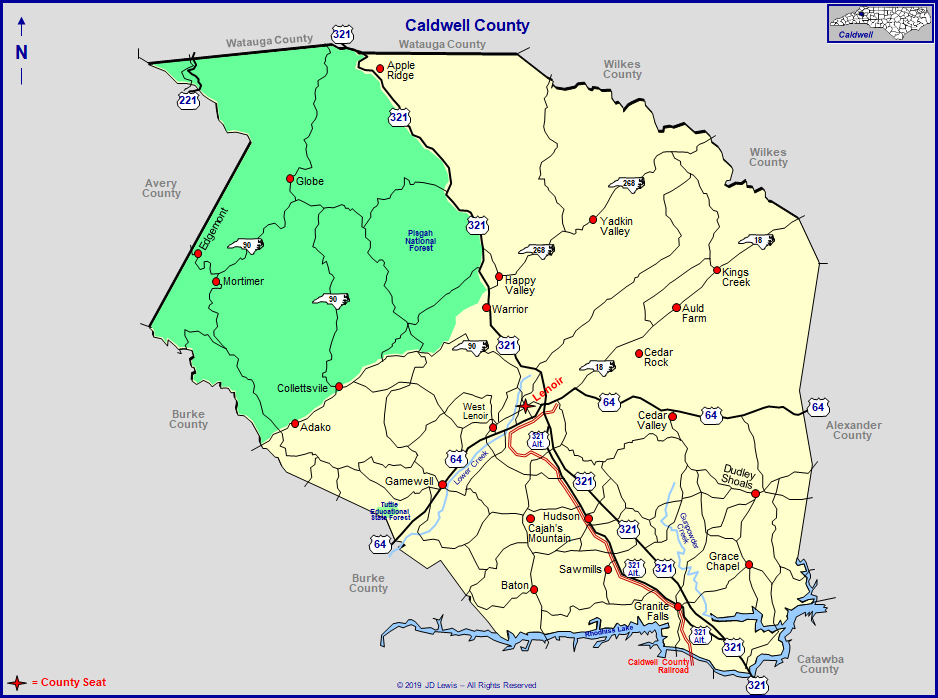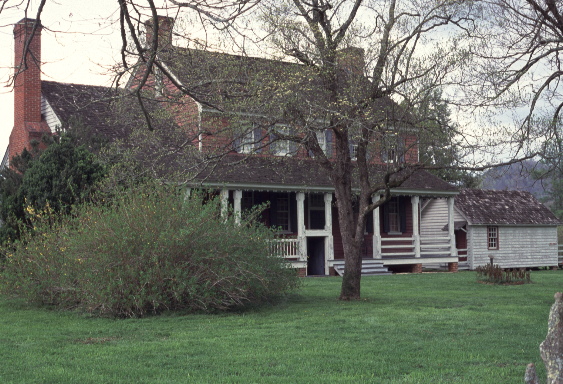 |
||||
|
|
||||
|
|
|
|
|
|
|
|
|
|
|
|
|
|
|
|
|
|
|
|

|
|
|
|
|
|
|
|
|
|
|
|
|
|
|
|
|
|
|
|
|
|
|||
|
Caldwell County was formed in 1841 from Burke and Wilkes counties. It was named in honor of Joseph Caldwell, the first President of the University of North Carolina He strongly advocated a public school system and a railroad across the center of the state from Morehead City in the east to Tennessee in the west. It is in the west-central section of the state and is bounded by Alexander, Catawba, Burke, Avery, Watauga, and Wilkes counties. The present land area is 471.60 square miles and the 2010 population was 83,029. The court was ordered to be held at the store of George Powell near the house of George Smith, Jr., until a court house was erected. Commissioners were named to select a site as near the center as possible, acquire land and a town, and erect a courthouse. Lenoir, named in honor of William Lenoir, is the county seat.  Fort Defiance - Caldwell County, North Carolina Fort Defiance, located in the Happy Valley community on Highway 268, General William Lenoir built his home between 1788 and 1792 on the former site of the Revolutionary War fort, which was designed to protect settlers from the early Native Americans in the area. The home of William Lenoir has been fully restored to its late eighteenth, early nineteenth century grandeur and features over 300 pieces of original furnishings and artifacts. Caldwell County, carved from the counties of Burke and Wilkes, was actually formed in January of 1841, several weeks after the bill was introduced in the North Carolina legislature. The bill to establish the county was rejected in 1839 because a faction within the state legislature wished to form two Democratic counties instead of one Whig county. The bill was re-introduced by Representative Elisha P. Miller on November 19, 1840. The bill of 1840 proposed to establish a county from Burke and Wilkes to be named Boone. It was first read and rejected on December 5, 1840. It was read a second time and passed by the casting vote of the Speaker, Robert B. Gilliam on December 14, 1840. There was some confusion over the selection of the name, however, but when Charles Manley, Clerk of the House, suggested to Representative Miller that the county be named for Dr. Joseph Caldwell, former President of the University of North Carolina and advocator of a public school system and a railroad system stretching from Morehead City through the proposed county to Tennessee, the bill was ratified and signed on January 11, 1841. The original settlement of Lenoir was first known as Tucker’s Barn. The community of Tucker’s Barn, which was settled by a family named Tucker around 1765, was on the north side of Lower Creek. Their home became a gathering place for many occasions. It was a voting precinct, a muster ground, a store and a place for “frolics” and celebrations. At least one large Fourth of July celebration included a drum corps, a march of Revolutionary veterans and speeches by General William Lenoir, Edmund Jones, Parson Miller, the McDowells and a barbeque. The place was so popular that a piece of music suitable for violins was composed by a musician and entitled “Tucker’s Barn.” In the first U.S. Census of North Carolina taken in 1790 is recorded all the names of all the heads of families living around Tucker’s Barn. These citizens composed the Ninth Company of the Morgan District North Carolina Militia and included: George Tucker, Peter Thompson, Fred Grider, Sr., Fred Grider, Jr., John Grider and Jacob Grider. The author of "Here Will I Dwell," states that the barn was near the present junction of West Harper Avenue and Beall Street and that the Tucker School was nearby. However, the first Tuckers in the area seem to have settled in the vicinity of Norwood Street and Pennton Avenue giving rise to stories the barn was there. Another location sometimes cited is where Highway 18 crosses Highway 321 on the site of the present Lenoir Crossings Shopping Center. This location is probably given because the Tucker Cemetery is near the shopping center. The Tuckers were apparently large property owners with many acres of land covering all three of these locations. When Caldwell County was formed a commission appointed to lay off a county town met to decide upon a location. There was some division over a proper site. One party favored the south side of Lower Creek, the present day Whitnel Area, because of the scenic visibility of the Blue Ridge, but since the bulk of the citizenry lived on the north side of Lower Creek, Tucker’s Barn was chosen. The choice was made because of the accessibility of Tucker’s Barn in the event of a Spring “freshet.” The commission charged with the responsibility of laying a 25-acre site for court house and jail consisted of: Catlett Jones, Edmund Jones, William Dickson, Daniel Moore, Sr., William Watson, John Blair, Sr., Levi Laxton, Sr., Peter Ballew, Jr., and Abner Pain. The new county seat was named Lenoir in honor of General William Lenoir. 1771 - The region’s settlers petitioned for creation of a new county. 1790 - The Caldwell area had a population of about 2,675 1791 - Caldwell’s first industries were located on Gunpowder Creek, near Granite Falls. Here the Pierce Iron Forge was erected and gunpowder was manufactured for the patriots. 1825 - Tucker’s Barn area became the seat of government of the new county. 1850 - A toll road was built across the Blue Ridge to Blowing Rock – a road that is now U.S. Highway 321. 1878 - Grist and sawmills were developed along streams within the county. The county had 51 grain mills, 41 sawmills and five furniture shops, eight tanneries, a pottery, an implement factory, four gold mines, and innumerable iron ore beds. 1884 - The Chester and Lenoir Railway (a narrow gauge) came to the county. 1889 - The first modern furniture factories were organized. 1910 - There were 2,548 farms in the county. 1938 - Caldwell was one of the first counties to achieve a rural electrification program. |
|||
 |
 |
© 2022 - J.D. Lewis - PO Box 1188 - Little River, SC 29566 - All Rights Reserved